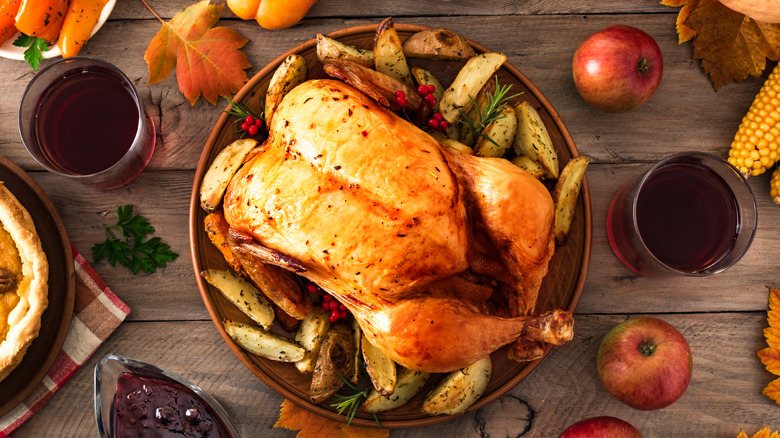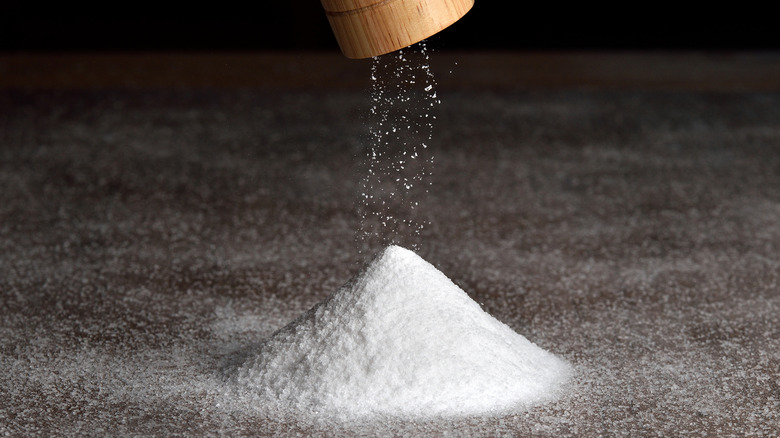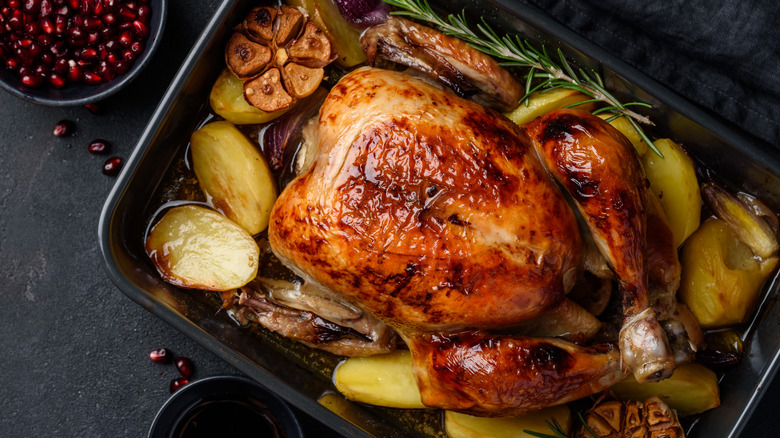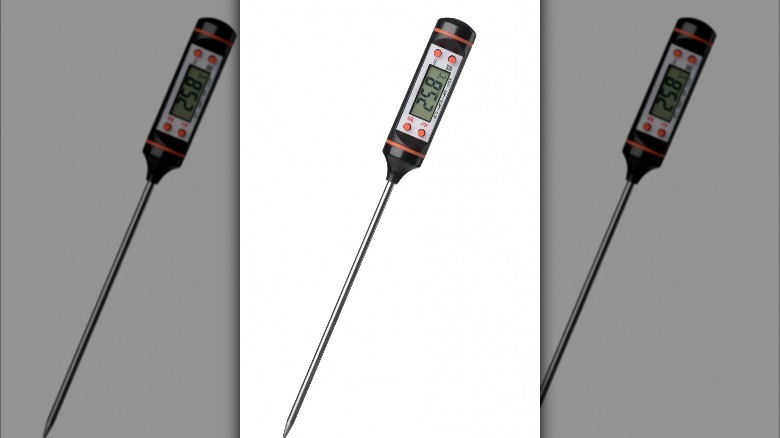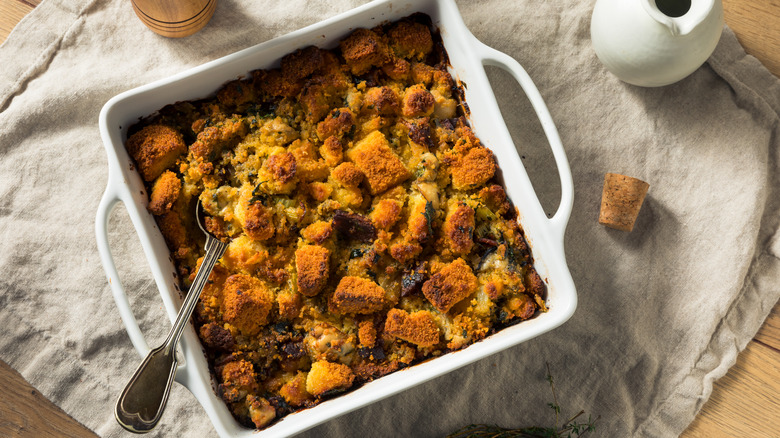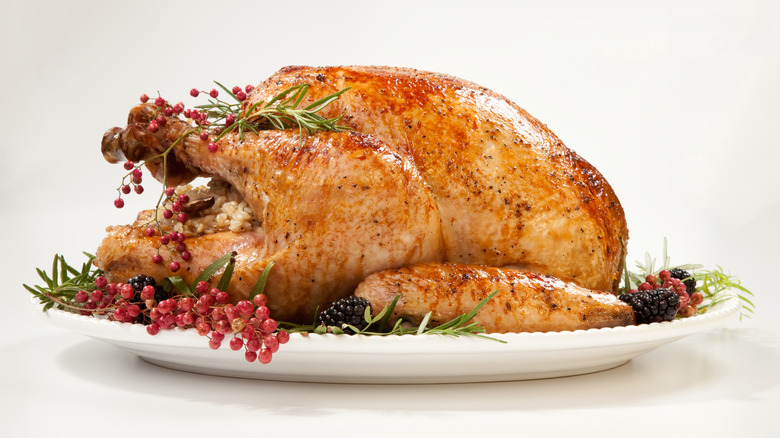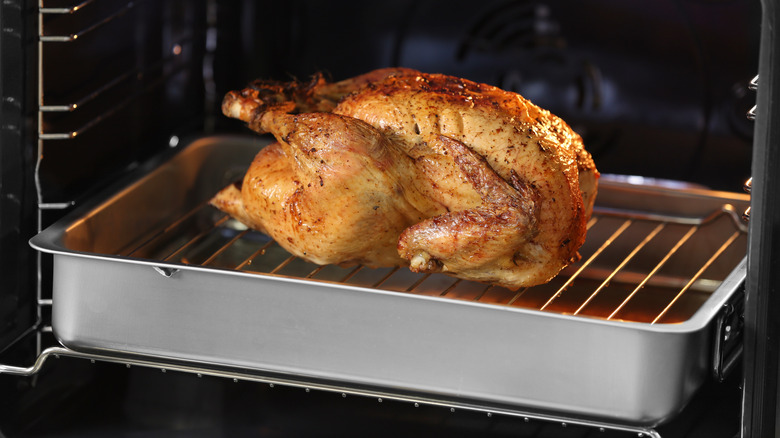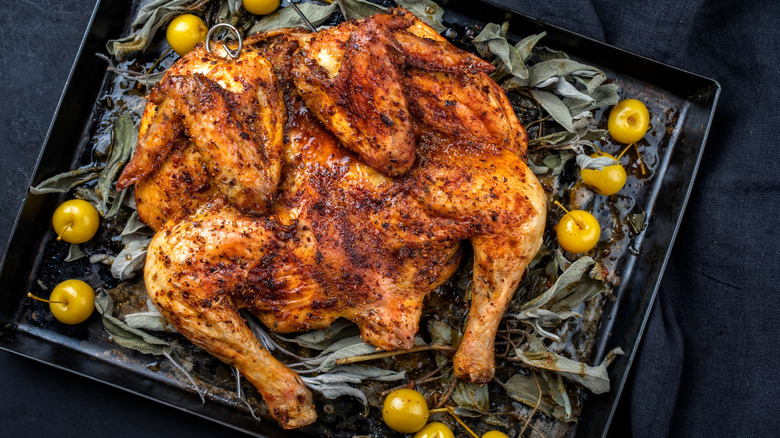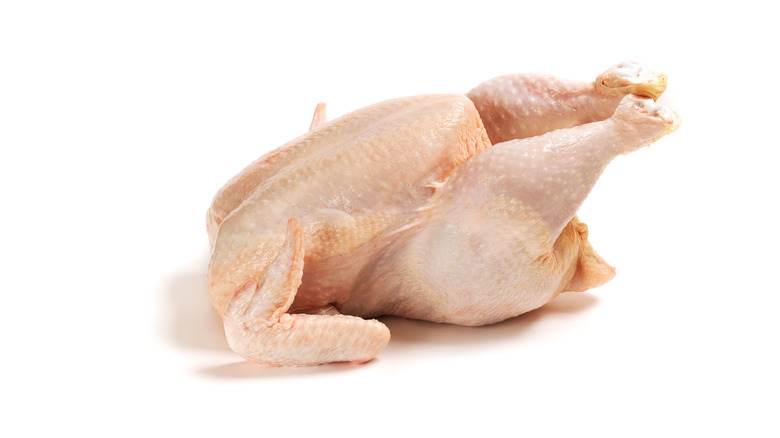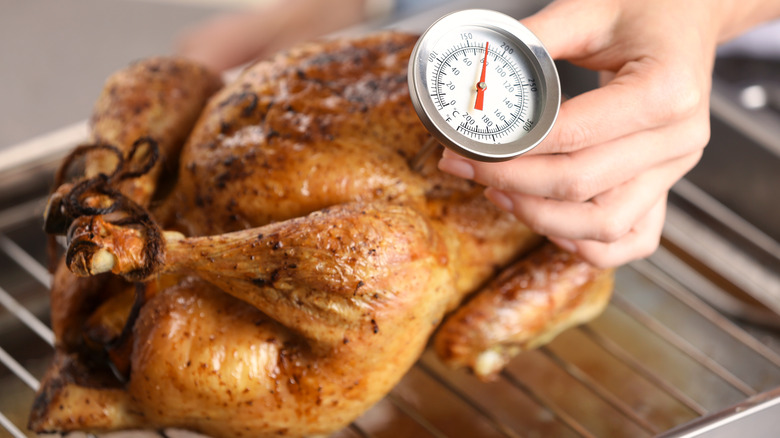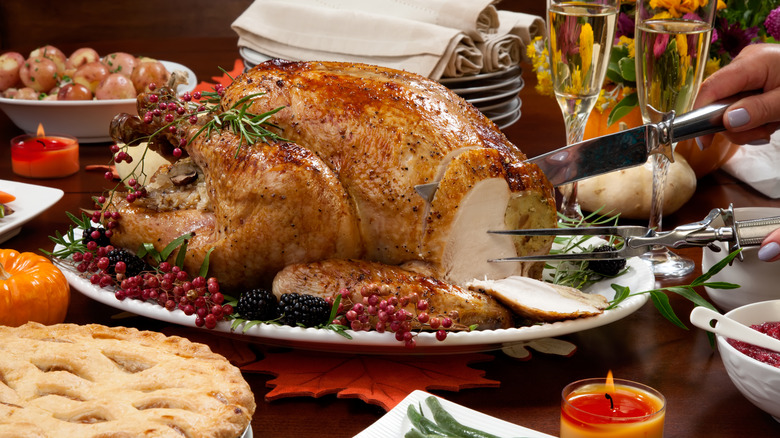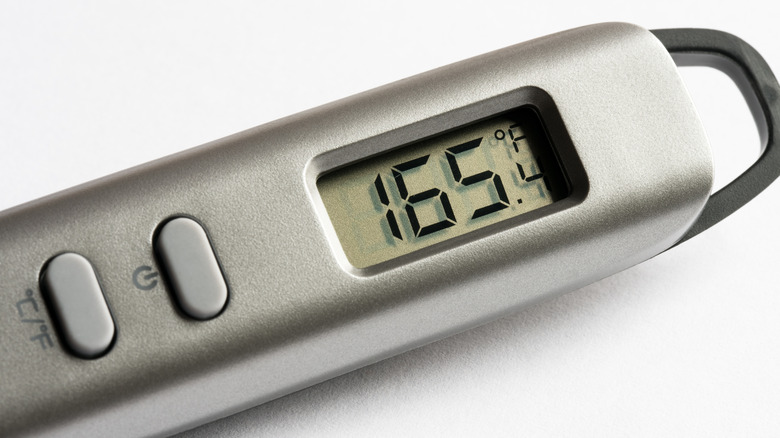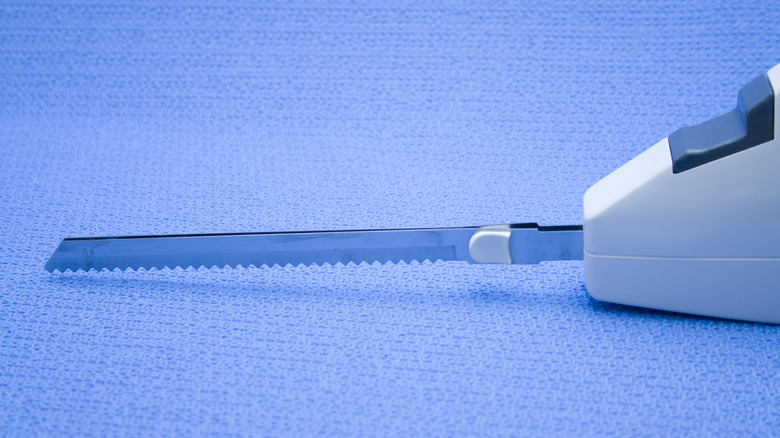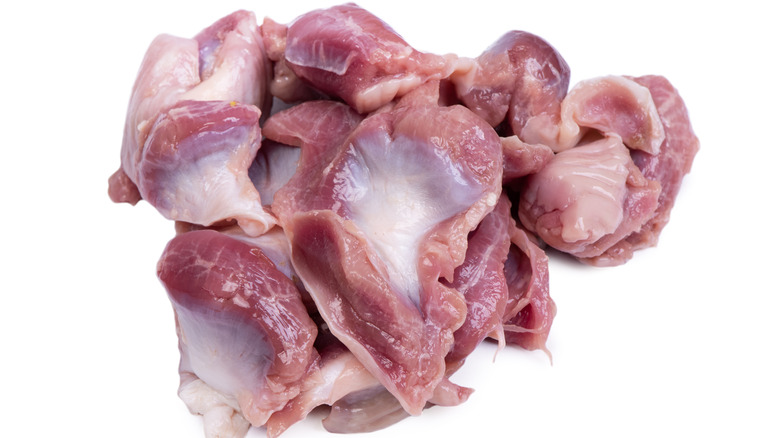Here's The Right Way To Roast A Turkey
Although its alleged presence at the first Thanksgiving dinner in 1621 may be an ahistorical fabrication, there's no denying turkey's place as the centerpiece of any American Thanksgiving spread. That doesn't mean everybody's happy about it. A Mashed survey found that almost 18% of people would gladly stop serving it at their Thanksgiving dinners if they could. Many people say that they hate cooking turkey, and it accounts for more Thanksgiving day fails than any other dish. Turkey is a lean, gamey bird, and it's unforgiving for home cooks who may only roast whole poultry once or twice a year.
Despite turkey's unsavory reputation, we're here to tell you that America's native fowl is misunderstood. If treated with care and affection, turkey can be just as delicious and succulent as its beloved little brother, chicken. Proper turkey cookery requires some judiciously applied technique, generous seasoning, and careful timing. We're not going to lie and say that it's the easiest cooking project in the world, but it is worthwhile. Most of us have to eat turkey on Thanksgiving, so we should try our best to make it taste good. With this guide, you should be able to roast a tasty turkey every Thanksgiving or any other day of the year.
Dry brining seasons your turkey to the core
Brining is the secret to creating moist, well-seasoned turkey, but traditional wet brining methods come with some annoying drawbacks. For one, to brine a whole turkey you need a very large food-safe container, larger than many people have in their kitchens at home. Wrangling an unwieldy bucket filled with saltwater and a whole turkey is an opportunity to make a big mess and splash salmonella juice all over your kitchen. Also, all the extra water from the brining process can make the turkey skin paler and less crispy. For all these reasons, dry brining is the best, easiest way to make your turkey more delicious before cooking (via The Kitchn).
In a dry brine, you take all the basic components of a brining solution like salt, sugar, and spices, and sprinkle them on the skin and inside the cavity of your turkey at least a day before Thanksgiving. (Several days of curing time is even better.) The salt will penetrate the interior of the meat, seasoning all the way down to the bone if you give it enough time.
Dry brines can be as basic as just kosher salt, but ingredients like brown sugar, ground spices, herbs, and even MSG can help take your turkey to the next level. If you want to switch up the Thanksgiving formula this year, you can try Tasting Table's recipe for dry-brined Sichuan-spiced turkey.
For crispier skin, add fat
Unlike richer birds like duck and goose, turkey doesn't have much subcutaneous fat. The fat in duck skin melts as the bird roasts, almost frying the skin and making it naturally crispy. Turkey skin needs some help to achieve the shatteringly-crisp, golden-brown finish we all want. Adding fat to the outside of the turkey will prevent the skin from sogging out and promote even browning. PopSugar talked to America's foremost turkey experts at Butterball, who recommended coating turkey in neutral oil or clarified butter to encourage browning. Butterball's set it and forget it method of brushing the turkey with oil at the beginning of the cooking process asks very little of the cook, but you can achieve even better results if you apply fat throughout the cooking process. This recipe from Bon Appétit suggests basting the turkey with butter infused with soy sauce, garlic, and herbs every 15 minutes to produce an evenly-burnished glow.
Let your turkey come to room temperature before cooking
Like many other proteins, turkey benefits from coming to room temperature before you cook it. Although it's not strictly necessary, letting your turkey rest at room temperature for an hour will improve your cooking experience in a couple of ways. Firstly, a 70-degree Fahrenheit turkey will cook significantly faster than a fresh-from-the-fridge 34-degree turkey (via Bon Appétit). Your bird will also cook more evenly if given a chance to temper before roasting. This resting period has the added benefit of allowing moisture to evaporate from the surface of the turkey, drying out the skin. Less water equals more browning, so a tempered turkey is going to come out crispier than one that went straight from the fridge to the oven.
You might be worried that letting raw meat sit out at room temperature is a food safety hazard, but since you're cooking the meat after it tempers, the risk of illness is very low. Of course, there's a limit to this logic, and we wouldn't recommend leaving your turkey out at room temperature for more than two hours.
Stuffing makes it more difficult to cook the turkey safely
Although cooking stuffing inside the turkey is a time-honored and delicious tradition, many modern guides to Thanksgiving prep advise cooks to bake the stuffing in a separate tray rather than putting it in the bird. Technically, since the dish isn't stuffed inside the bird, it's called dressing when prepared this way. The reasons for this shift away from traditional stuffing are twofold. First, improperly cooked stuffing can be a safety hazard. Stuffing must reach an internal temperature of 165 degrees Fahrenheit to ensure all harmful bacteria are killed. You can't make the mistake of only checking the temperature of the turkey, as it may finish cooking before the stuffing has exited the temperature danger zone. Second, stuffing slows down the overall cooking process, which could potentially dry out the turkey.
If you grew up eating stuffing that came from inside a turkey, you know that dressing can never fully replicate traditional stuffing's rich turkey flavor. The cooks at "America's Test Kitchen" answered some questions on NPR, and while they were generally anti-stuffing, they had a useful tip to mitigate some of the pitfalls of cooking a stuffed bird. They recommended microwave the stuffing until hot (around 130 degrees) so it won't drop the temperature of the bird excessively and cook faster than a turkey filled with cold stuffing. The hot stuffing will also take less time to reach 165 degrees, so it will be done at the same time as the turkey.
Breasts cook faster than thighs
One of the trickiest aspects of cooking a whole turkey is that it's composed of two very different types of meat: breast and leg. Not only do the breasts cook faster than the dark meat, but they will become totally dry if cooked to the temperature that leg meat needs to reach maximum deliciousness (via Serious Eats). Generations of crafty home cooks have come up with numerous hacks to avoid overcooking the turkey breast. Two of the most popular methods are using aluminum foil to cover the breasts once they finish cooking, and starting the turkey breast-side-down in the oven to protect the breast meat (via How Stuff Works).
If you don't care about taking a picture with the whole bird tableside, you can follow this method from Tasting Table and carve the breasts off when they finish cooking, returning the dark meat to the oven for the rest of its cooking time. This will give you juicy white meat every time.
A roasting rack ensures browning all around the turkey
Some kind of roasting rack is essential for a picture-perfect, evenly browned turkey. Although it might seem unnecessary to add this extra piece of equipment when you could just throw a turkey in a pan and cook it in the oven as is, the roasting rack will (literally) elevate your turkey game. A turkey sitting in the bottom of a roasting pan will begin to stew in its own accumulated juices. The moisture will make the bottom of the bird flabby, pale, and sad. By raising the turkey safely above the liquid in the pan, a roasting rack allows the hot, dry air in the oven to crisp up every inch of turkey skin.
If Thanksgiving is the only time you roast a large hunk of meat at home and you don't want to buy a unitasker kitchen gadget that will gather dust in the cabinet 364 days out of the year, you can always DIY your own rack. This Tasting Table recipe uses a bed of root vegetables to support the turkey. The vegetables have the added benefit of contributing flavor to the turkey drippings you'll use for gravy. You can also jerry-rig a serviceable roasting pan with aluminum foil.
For bold nontraditionalists, spatchcocking is the way to go
Many of us cherish the spectacle of a whole golden bird presented at the Thanksgiving table, with the host carving the bird while the guests sit and watch. If this is important to you, or if you cling to stuffing your turkey, feel free to leave your turkey whole. Likewise, if the idea of adding some mild poultry butchering to your Thanksgiving prep list is a little daunting, it's okay to go the traditional route. If, however, you're comfortable with ripping the backbone out of a raw turkey and you want the tastiest possible meat on Thanksgiving, spatchcocking is for you (via Serious Eats).
Spatchcocking is surprisingly not dirty Cockney slang, but a method for flattening out a whole bird so it cooks more evenly. First, you cut out the turkey's spine with poultry shears or a knife, then you use brute force to crush its breastbone so it lays flat. Writing for Serious Eats, J. Kenji Lopez-Alt says this method improves the turkey in several ways. It evens out the cooking time between the breasts and thigh and makes the skin crispier. It also reduces roasting time by about half and gives you a spare turkey spine to enrich the broth you use for gravy and stuffing. Some people will never be able to get past a spatchcocked turkey's rather ungainly appearance (and we really have to do something about that name!) but it's a surefire shortcut to a more delectable Thanksgiving turkey.
Thawing takes longer than you think
Give your turkey plenty of time to thaw. If your bird is still frozen on the inside when you put it in the oven, you could be setting yourself up for an infectious situation. Don't just let your turkey hang out on the counter all day, either. The best, safest way to thaw your turkey (which is, unfortunately, also the slowest) is to thaw it in the fridge. You need about a day for every four pounds of turkey, which for a big bird could mean more than half a week. Your turkey is going to leak a lot of juice as it thaws, so make sure it's sitting in a pan that's large enough to accommodate all the liquid so your fridge doesn't turn into salmonella city.
If that method seems like a pain, or if you bought a turkey the day before Thanksgiving and don't have a week to prepare, don't lose hope. It's also safe to thaw a turkey fully submerged in cold water. Just make sure that your container is either sitting under a slow tap or that you change the water frequently. This method can thaw a 12-pound turkey in around six hours. If you bought your turkey in a blind panic on Thursday morning, you can go straight from freezer to oven. This will take about 1.5 times as long and not taste as good as a thawed turkey, but it will save Thanksgiving and won't send anyone to the hospital (via The Spruce Eats).
Blast it with heat when it first goes in the oven
The classic way to cook a turkey is to roast it slowly at a relatively low temperature, around 325 F. Southern Living recommends this method for people who require a low-maintenance turkey because of everything else they need to do on Thanksgiving. This procedure can produce a fine bird, but can tend to dry out the meat slightly because the turkey spends more time in the oven than with higher-heat methods. You can guard against this by basting with some kind of fat every 20 minutes or so, although that detracts from the simple appeal of this strategy.
The more professional, and faster, way to cook a turkey is to start it in a searing-hot oven for the first bit of cooking time and then lower the temperature to cook the meat all the way through. Tasting Table advocates for a double-drop method in which you preheat the oven to 475 degrees, go down to 425 F when you insert the turkey, then reduce to 350 F once the skin has seared. Not only does this technique take less time than the low-and-slow method, but it also gives you crispier skin and juicier meat.
Plan for at least a pound of turkey per person
If you're like us, you don't often buy large cuts of bone-in meat to feed a crowd, so it can be hard to figure out what size of turkey you need to purchase. Fortunately, the calculations required for turkey acquisition are relatively simple. According to Lehigh Valley Live, you need one pound of turkey for every guest you're serving. If you're very popular and are hosting an enormous number of people, you can start reducing this for turkeys larger than 16 pounds, as they have proportionally more meat and less bones by weight.
Keep in mind that this estimate is the minimum that will ensure that every person at your table is fed. For many of us, the greatest joy of Thanksgiving is not the dinner itself, but all the leftovers we get to put into recipes after the fact. If you want to make sure to cook enough turkey for Moist Makers the next day, allot 1.5 pounds of turkey per person (via The Kitchn).
Let it rest for half an hour before carving
Although the sight of your golden-brown, delicious turkey might make you want to reach for the carving knife immediately, premature puncture can ruin a perfectly-cooked turkey. When you apply heat to a piece of protein, the liquid inside becomes more volatile. If you cut into a big hunk of meat right after it's done cooking, the juice will rush out, leaving you with a sad, gray, dry mess (via Martha Stewart).
Resting is doubly important for whole animals like turkeys, as their large mass means that they will continue to cook and increase in temperature for several minutes after they come out of the oven (via The New York Times). That means you can stop the cooking process several degrees before your final target temperature, knowing that carryover cooking will take you over the finish line. This gentle exit will make your turkey juicier and more tender. Although it might be frustrating to add another half hour of waiting to an already hours-long process, you will be able to use the extra time for last-minute tasks like making gravy and corralling your guests.
Don't pay attention to that popping thermometer
Most mass-market frozen turkeys come with a little thermometer inserted into the breast meat that pops out when the turkey is "done." While in theory, this feature would be a boon to home cooks who don't have meat thermometers, these popping timers have a major flaw: They're set to go off at 178 degrees Fahrenheit (via Cook's Illustrated). Dark meat can handle getting that hot, but breast meat will turn into sawdust and sadness at that temperature.
Turkey producers might have set that high temperature from some misguided notions about food safety, but they're not doing their product any favors by encouraging consumers to cook it until it's desiccated. Academics at Michigan State University say that turkey is safe once it reaches 165 degrees, and some chefs advocate for even lower temperatures, saying that resting and carryover cooking allow you to remove the bird from the oven before it gets to 165.
Don't use an electric carving knife
Carving a whole turkey is an intimidating task for most kitchen amateurs, and it might be tempting to buy a special gadget that promises to make the process easier. Americans' insatiable appetite to buy stuff we don't need has made it seem like electric knives are necessary for properly dismembering a turkey, but in reality, all you need is a good chef's knife (via The Food Network). Electric knives are actually pretty good, and they might be better at keeping turkey skin intact than a standard knife, but they just aren't worth the expense or the space they take up (via Gear Patrol). They're made by clipping together two separate serrated blades and attaching them to a motor that makes them move back and forth. All of the tight spaces and small parts in an electric knife are perfect breeding grounds for bacteria and rust.
Electric knives are also obnoxiously loud, reaching an ear-splitting 90 decibels. In all likelihood, you're going to use your electric knife a maximum of three times per year. Given that the normal chef's knife in your cutlery drawer, if properly sharpened, will do just as good a job as the fancy electric one, you're better off saving your money on this superfluous appliance.
Save your giblets
Giblets are rivaled only by spatchcocking as the worst-named thing associated with Thanksgiving. It's likely that the only time you've thought about the little bag of innards that comes packaged inside your turkey was when it started smoking halfway through the cooking time because you forgot to take it out before you put the turkey in the oven.
Americans don't cook much with organ meats, so a bag full of turkey liver, heart, kidneys, and neck might seem like trash to the average cook, but the Food Network notes that little sack contains a world of great flavor if you have the patience to extract it. Turkey liver helps amplify the savoriness of a normal stuffing recipe and simmering the neck and other organs in your turkey broth will make your gravy taste more delicious. If you choose not to include the giblets in your Thanksgiving dinner, you can make them into standalone dishes like liver pate or grilled heart.
